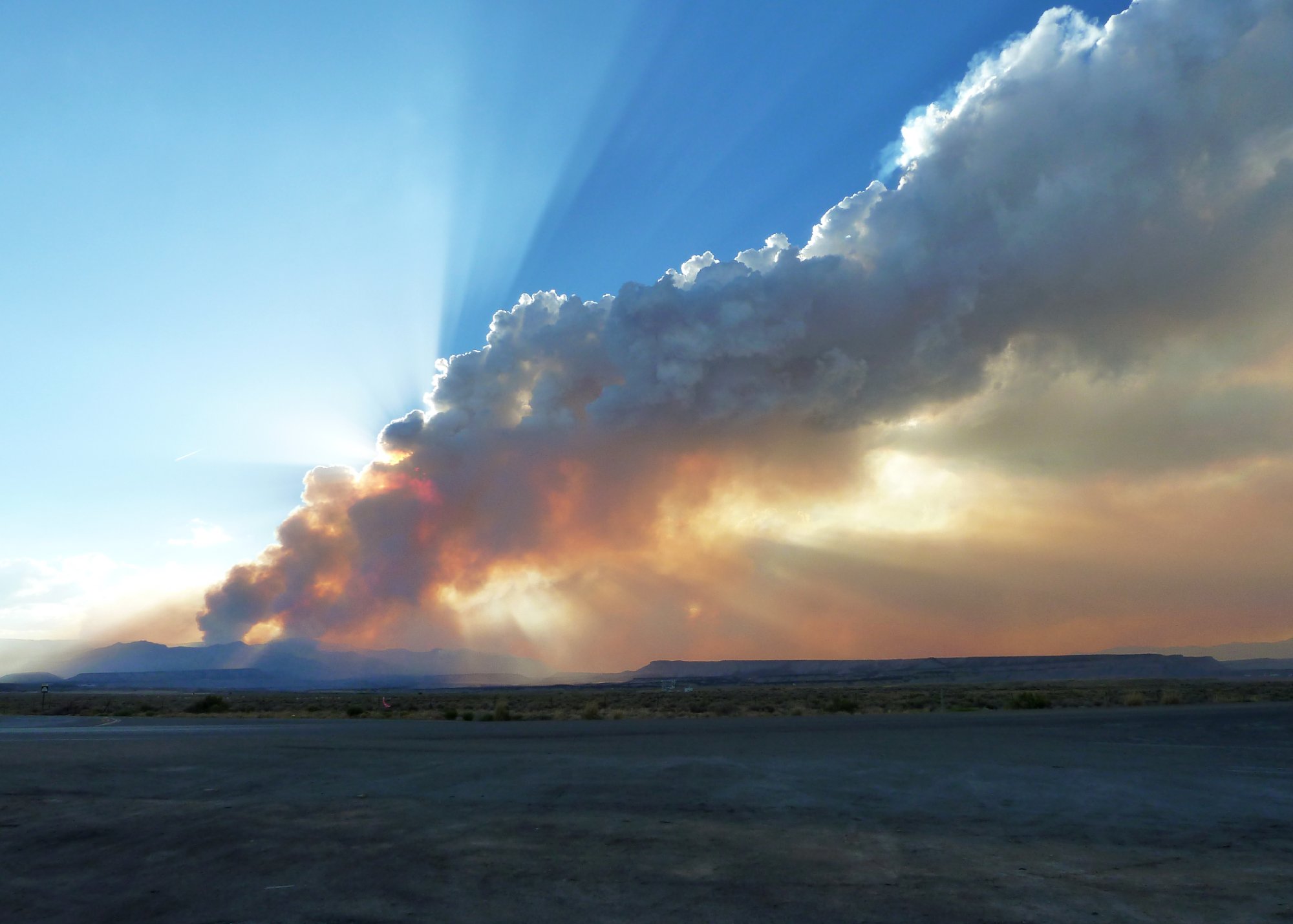WILDFIRE
Wildland fires often begin unnoticed, spread quickly, and are usually sighted by dense smoke.
They help to maintain a healthy ecosystem and have been a natural and fundamental part of
the world’s forests and grasslands for millions of years. Fires cleanse and regenerate forests,
giving new life to the soil and encouraging biodiversity. They are responsible for the evolution of
many of the grasses, brushes, and tree species found in Utah.
A wildfire is an uncontrolled fire spreading through vegetative fuel, often consuming structures
and wildlife in its path. Wildfires are classified as Wildland and Wildland-Urban Interface (WUI).
Wildland fires occur in areas where development is essentially nonexistent except for roads,
railroads, or power lines. WUI fires materialize in a geographical area where structures and other
human development adjoins wildlands. A fireshed is an area that will adversely affect a
community or high-value resource and/or asset if ignited.
Three basic elements are needed for a fire to occur: (1) a heat source (2) oxygen, and (3) fuel.
Ignition sources for wildfires can be natural, accidental or incendiary. Utah’s wildfire risk
potential changes from year to year. Variables that influence wildfire risk include vegetation fuel
sources, snow totals, precipitation, ground moisture saturation and temperature. Once a wildfire
starts, vegetation, topography and weather are all contributing factors in the rate of spread of
the fire’s growth.

In 2006, Utah experienced 1,843 wildfires with 13 burning more than 5,000 acres. In 2007, 1,385 wildfires burned nearly 650,000 acres including the largest wildfire to date in Utah’s recent recorded history at Milford Flat which destroyed 363,052 acres in Millard and Beaver Counties. That same year the Neola North fire resulted in three fatalities.
When the 2007 fire season was over, Utah’s Division of Air Quality reported 40 days of unhealthy air, 24 days more than the previous year and in Millard County dust storms created hazardous
driving conditions on I-15 for months. Burn bans implemented due to air pollution and poor air quality impact the ability of the Utah Division of Forestry, Fire, and State Lands (FFSL) to do prescribed wildland maintenance burns in Utah.
In 2012 and 2013 Summit and Millard Counties had large wildfires resulting in FMAG declarations
for the Clay Springs and Rockport fires. In 2015, Utah enjoyed a small reprieve when only 10,203
acres burned, but the next year 101,096 acres were ravaged by wildfire at an estimated cost of
$45 million. The two largest fires in 2016 were both ignited by lightning. The West Antelope Fire
scorched 13,740 acres, half the Great Salt Lake’s Antelope Island and the Briggs Fire consumed
8,883 acres and forced wildlife officials to relocate 140 native Bonneville cutthroat trout from a
Beaver County stream to the south fork of North Creek due to increased levels of sediment and
therefore water conditions are incompatible for aquatic life.
1,166 wildfires were recorded in 2017, totaling 249,829 acres burned in Utah.26 The Brian Head
Fire was human caused and destroyed 71,673 acres and lightning caused the Onaqui Mountain
Complex fire which consumed 37,942 acres. See Figure 4-121 for a breakdown of total acres
burned from wildfires in Utah between 2022 and 2022.
 Read the entire wildfire chapter
Read the entire wildfire chapter
CASE STUDY

Seeley Fire near Emery County's Huntington Canyon 2012
During the summer of 2012, Utah had a particularly active wildland fire season. Fires throughout the state caused considerable damage to resources, infrastructure and personal property. Following this severe fire season, Governor Gary Herbert created the Catastrophic Wildfire Reduction Steering Committee tasked with developing a strategy to reduce the size, intensity, and frequency of catastrophic wildfires in Utah.
Utah lawmakers also authorized approximately $2 million of state funds to create a Catastrophic Wildfire Reduction Strategy that could only be utilized for implementation efforts, primarily fuels mitigation projects. Six regional working groups were established to assess risk and prioritize projects across Utah. As the program matures, the state will improve landscape resilience through fuels mitigation and prescribed fire projects, assist and educate human populations with preparing for and withstanding fire events, and continue to provide and improve timely and effective fire suppression response.
The Ready, Set, Go! (RSG) Program managed by the International Association of Fire Chiefs (IAFC) launched in 2011 to help fire departments educate residents in high risk wildfire areas to prepare their properties to mitigate fire hazards. The initiative is a personal wildland fire action guide for residents that correlates to the state's Firewise Communities Program and other wildland fire public education efforts. All growing counties in Utah are encouraged to follow FEMA's Firewise construction recommendations for all new development areas to minimize wildfire risk. The Firewise program assists neighborhoods to mitigate wildfire hazards. There are currently 28 Firewise communities in Utah.
